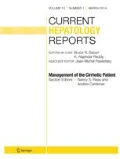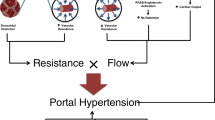Abstract
Acute esophageal variceal hemorrhage is one of the clinical events that define decompensated cirrhosis and is associated with high rates of morbidity and mortality. Although recent treatment strategies have led to improved outcomes, variceal hemorrhage still carries a 6-week mortality rate of 15-20 %. Current standards in its treatment include antibiotic prophylaxis, infusion of a vasoactive drug and endoscopic variceal ligation. The placement of a transjugular intrahepatic portosystemic shunt (TIPS) is considered for patients that have treatment failure or recurrent bleeding. Recurrent hemorrhage is prevented with the combination of a non-selective beta-blocker and endoscopic variceal ligation. These recommendations however assume that all patients with cirrhosis are equal. Based on a review of recent evidence, a strategy in which patients are stratified by Child class, the main predictor of outcomes, is proposed.


Similar content being viewed by others
References
Papers of particular interest, published recently, have been highlighted as: • Of importance •• Of major importance
Garcia-Tsao G, Bosch J. Management of varices and variceal hemorrhage in cirrhosis. N Engl J Med. 2010;362:823–32.
Carbonell N, Pauwels A, Serfaty L, et al. Improved survival after variceal bleeding in patients with cirrhosis over the past two decades. Hepatology. 2004;40:652–9.
Stokkeland K, Brandt L, Ekbom A, et al. Improved prognosis for patients hospitalized with esophageal varices in Sweden 1969-2002. Hepatology. 2006;43:500–5.
Garcia-Tsao G, Sanyal AJ, Grace ND, et al. Prevention and management of gastroesophageal varices and variceal hemorrhage in cirrhosis. Hepatology. 2007;46:922–38.
Moitinho E, Escorsell A, Bandi JC, et al. Prognostic value of early measurements of portal pressure in acute variceal bleeding. Gastroenterology. 1999;117:626–31.
Monescillo A, Martinez-Lagares F, Ruiz-del-Arbol L, et al. Influence of portal hypertension and its early decompression by TIPS placement on the outcome of variceal bleeding. Hepatology. 2004;40:793–801.
Abraldes JG, Villanueva C, Banares R, et al. Hepatic venous pressure gradient and prognosis in patients with acute variceal bleeding treated with pharmacologic and endoscopic therapy. J Hepatol. 2008;48:229–36.
Amitrano L, Guardascione MA, Manguso F, et al. The effectiveness of current acute variceal bleed treatments in unselected cirrhotic patients: refining short-term prognosis and risk factors. Am J Gastroenterol. 2012;107:1872–8.
Cazzaniga M, Dionigi E, Gobbo G, et al. The systemic inflammatory response syndrome in cirrhotic patients: relationship with their in-hospital outcome. J Hepatol. 2009;51:475–82.
Kravetz D, Sikuler E, Groszmann RJ. Splanchnic and systemic hemodynamics in portal hypertensive rats during hemorrhage and blood volume restitution. Gastroenterology. 1986;90:1232–40.
Castaneda B, Morales J, Lionetti R et al. Effects of blood volume restitution following a portal hypertensive-related bleeding in anesthetized cirrhotic rats. Hepatology. 2001;33:821–5.
Villanueva C, Colomo A, Bosch A, et al. Transfusion strategies for acute upper gastrointestinal bleeding. N Engl J Med. 2013;368:11–21. Multicenter large randomized controlled trial that shows that a restrictive transfusion strategy is associated with improved survival, less rebleeding rates and a decrease in portal pressure in a subgroup of patients with cirrhosis.
Bernard B, Cadranel JF, Valla D, et al. Prognostic significance of bacterial infection in bleeding cirrhotic patients: a prospective study. Gastroenterology. 1995;108:1828–34.
Vivas S, Rodriguez M, Palacio MA, et al. Presence of bacterial infection in bleeding cirrhotic patients is independently associated with early mortality and failure to control bleeding. Dig Dis Sci. 2001;46:2752–7.
Bernard B, Grange JD, Khac EN, et al. Antibiotic prophylaxis for the prevention of bacterial infections in cirrhotic patients with gastrointestinal bleeding: a meta-analysis. Hepatology. 1999;29:1655–61.
Chavez-Tapia NC, Barrientos-Gutierrez T, Tellez-Avila F, et al. Meta-analysis: antibiotic prophylaxis for cirrhotic patients with upper gastrointestinal bleeding - an updated Cochrane review. Aliment Pharmacol Ther. 2011;34:509–18.
Fernandez J, del Ruiz A, Gomez C, et al. Norfloxacin vs ceftriaxone in the prophylaxis of infections in patients with advanced cirrhosis and hemorrhage. Gastroenterology. 2006;131:1049–56.
de Franchis R. Revising consensus in portal hypertension: report of the Baveno V consensus workshop on methodology of diagnosis and therapy in portal hypertension. J Hepatol. 2010;53:762–8.
Fernandez J, Acevedo J, Castro M, et al. Prevalence and risk factors of infections by multiresistant bacteria in cirrhosis: a prospective study. Hepatology. 2012;55:1551–61. Large prospective cohort study involving two time periods that describe the epidemiology of bacterial infections in patients with cirrhosis admitted with infection or developed infection while hospitalized. The study reveals that multidrug resistant bacteria are frequently isolated from nosocomial and healthcare associated infections. Other predictors of these infections are described.
Tandon P, Delisle A, Topal JE, et al. High prevalence of antibiotic-resistant bacterial infections among patients with cirrhosis at a US liver center. Clin Gastroenterol Hepatol. 2012;10:1291–8. A retrospective cohort study performed in patients with cirrhosis hospitalized in a liver unit in the United States. Nearly half of culture-positive infections were found to be related to multidrug resistant organisms. Predictors of these infections are described.
Pauwels A, Mostefa-Kara N, Debenes B, et al. Systemic antibiotic prophylaxis after gastrointestinal hemorrhage in cirrhotic patients with a high risk of infection. Hepatology. 1996;24:802–6.
Tandon P, Keough A, Bastiampillai RJ, et al. Child Pugh A patients with cirrhosis and acute variceal hemorrhage have low risk of bacterial infection. Hepatology. 2013;58(Suppl). Presented at the Liver Meeting, Washington, DC, November 2013.
Wells M, Chande N, Adams P, et al. Meta-analysis: vasoactive medications for the management of acute variceal bleeds. Aliment Pharmacol Ther. 2012;35:1267–78. A meta-analysis that evaluates the efficacy of vasoconstrictors for the treatment of acute variceal hemorrhage. Using 30 trials (3111 patients), it demonstrates that vasoactive drugs are associated with lower short-term mortality, transfusion requirements, improved acute hemostasis, and a shorter hospitalization.
Azam Z, Hamid S, Jafri W, et al. Short course adjuvant terlipressin in acute variceal bleeding: a randomized double blind dummy controlled trial. J Hepatol. 2012;56:819–24.
Lo GH, Perng DS, Chang CY, et al. Controlled trial of ligation plus vasoconstrictor versus proton pump inhibitor in the control of acute esophageal variceal bleeding. J Gastroenterol Hepatol. 2013;28:684–9.
D'Amico G, Pietrosi G, Tarantino I, et al. Emergency sclerotherapy versus vasoactive drugs for variceal bleeding in cirrhosis: a Cochrane meta-analysis. Gastroenterology. 2003;124:1277–91.
Altraif I, Handoo FA, Aljumah A, et al. Effect of erythromycin before endoscopy in patients presenting with variceal bleeding: a prospective, randomized, double-blind, placebo-controlled trial. Gastrointest Endosc. 2011;73:245–50.
Garcia-Pagan JC, Caca K, Bureau C, et al. Early use of TIPS in patients with cirrhosis and variceal bleeding. N Engl J Med. 2010;362:2370–9.
Augustin S, Altamirano J, Gonzalez A, et al. Effectiveness of combined pharmacologic and ligation therapy in high-risk patients with acute esophageal variceal bleeding. Am J Gastroenterol. 2011;106:1787–95.
Garcia-Pagan JC, Di PM, Caca K, et al. Use of early-TIPS for high-risk variceal bleeding: results of a post-RCT surveillance study. J Hepatol. 2013;58:45–50.
Hubmann R, Bodlaj G, Czompo M, et al. The use of self-expanding metal stents to treat acute esophageal variceal bleeding. Endoscopy. 2006;38:896–901.
Zehetner J, Shamiyeh A, Wayand W, et al. Results of a new method to stop acute bleeding from esophageal varices: implantation of a self-expanding stent. Surg Endosc. 2008;22:2149–52.
Dechene A, Adamzik M, Gerken G, et al. Acute bronchial obstruction following esophageal stent implantation for variceal bleeding. Endoscopy. 2009;41 Suppl 2:E146–7. doi:10.1055/s-0028-1119725.
Wright G, Lewis H, Hogan B, et al. A self-expanding metal stent for complicated variceal hemorrhage: experience at a single center. Gastrointest Endosc. 2010;71:71–8.
Mishin I, Ghidirim G, Dolghii A, et al. Implantation of self-expanding metal stent in the treatment of severe bleeding from esophageal ulcer after endoscopic band ligation. Dis Esophagus. 2010;23:E35–8.
Dechene A, El Fouly AH, Bechmann LP, et al. Acute management of refractory variceal bleeding in liver cirrhosis by self-expanding metal stents. Digestion. 2012;85:185–91.
Holster IL, Kuipers EJ, Van Buuren HR, et al. Self-expandable metal stents as definitive treatment for esophageal variceal bleeding. Endoscopy. 2013;45:485–8.
Thiele M, Krag A, Rohde U, et al. Meta-analysis: banding ligation and medical interventions for the prevention of rebleeding from oesophageal varices. Aliment Pharmacol Ther. 2012;35:1155–65.
Ko SY, Kim JH, Choe WH, et al. Pharmacotherapy alone vs endoscopic variceal ligation combination for secondary prevention of oesophageal variceal bleeding: meta-analysis. Liver Int. 2012;32:867–9.
Lo GH, Chen WC, Wang HM, et al. Randomized, controlled trial of carvedilol versus nadolol plus isosorbide mononitrate for the prevention of variceal rebleeding. J Gastroenterol Hepatol. 2012;27:1681–7.
Reiberger T, Ulbrich G, Ferlitsch A, et al. Carvedilol for primary prophylaxis of variceal bleeding in cirrhotic patients with haemodynamic non-response to propranolol. Gut. 2013;62:1634–41. A retrospective study demonstrating a favorable effect of low doses of carvedilol on hepatic venous pressure gradient, particularly in Child A patients. It also demostrates that hemodynamic "responders" have a decreased rate of first variceal hemorrhage and decompensation.
Minano C, Garcia-Tsao G. Clinical pharmacology of portal hypertension. Gastroenterol Clin N Am. 2010;39:681–95.
de Souza AR, La Mura V, Reverter E, et al. Patients whose first episode of bleeding occurs while taking a beta-blocker have high long-term risks of rebleeding and death. Clin Gastroenterol Hepatol. 2012;10:670–6.
Ripoll C, Genesca J, Araujo IK, et al. Rebleeding prophylaxis improves outcomes in patients with hepatocellular carcinoma. A multicenter case-control study. Hepatology. 2013;58:2079–88. Important case-control study showing that patients with HCC and variceal hemorrhage are less likely to receive secondary prophylactic therapy and the lack of this therapy is associated with a higher mortality.
Gonzalez A, Augustin S, Dot J, et al. Adding banding ligation is effective as rescue therapy to prevent variceal rebleeding in haemodynamic non-responders to pharmacological therapy. Dig Liver Dis. 2012;44:55–60.
Acknowledgements
Grant support: NIH P-30DK 034989
Compliance with Ethics Guidelines
ᅟ
Conflict of Interest
Brett Fortune and Guadalupe Garcia-Tsao declare that they have no conflicts of interest.
Human and Animal Rights and Informed Consent
This article does not contain any studies with human or animal subjects performed by the authors.
Author information
Authors and Affiliations
Corresponding author
Rights and permissions
About this article
Cite this article
Fortune, B., Garcia-Tsao, G. Current Management Strategies for Acute Esophageal Variceal Hemorrhage. Curr Hepatology Rep 13, 35–42 (2014). https://doi.org/10.1007/s11901-014-0221-y
Published:
Issue Date:
DOI: https://doi.org/10.1007/s11901-014-0221-y




